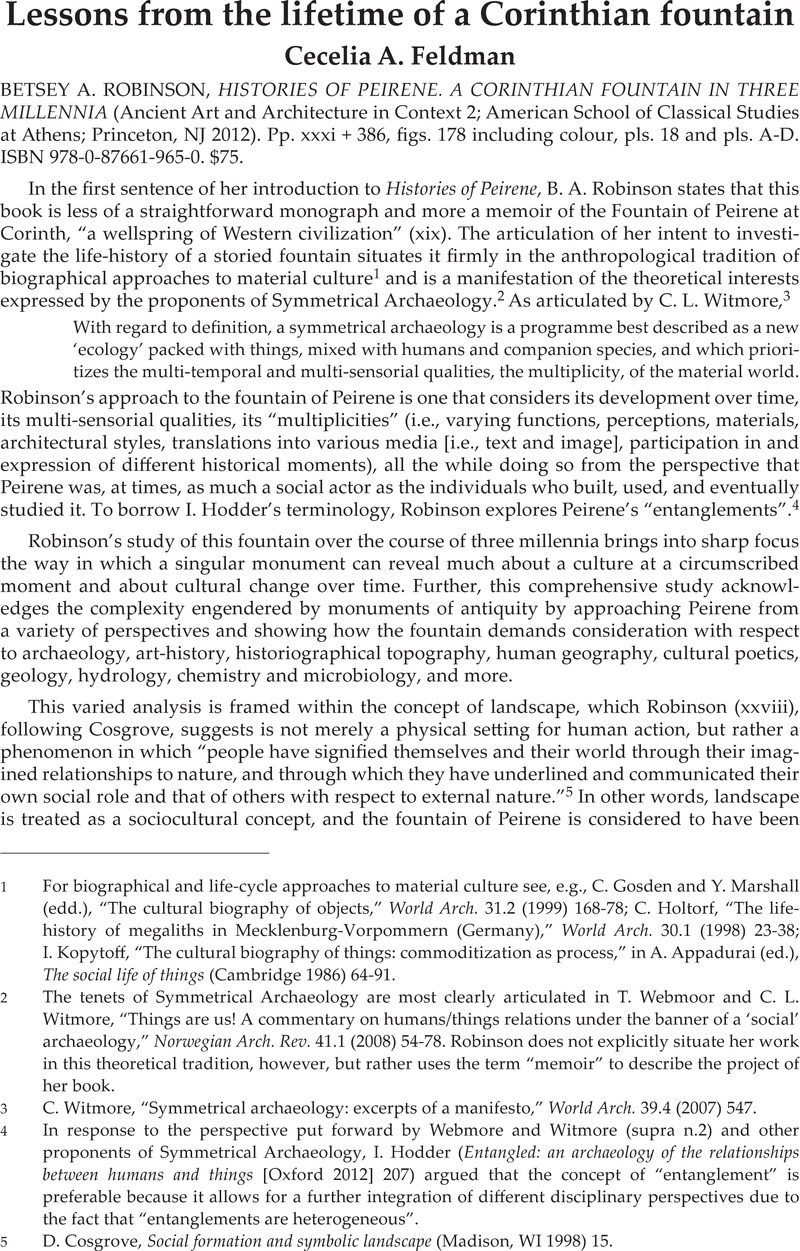No CrossRef data available.
Article contents
Lessons from the lifetime of a Corinthian fountain - BETSEY A. ROBINSON, HISTORIES OF PEIRENE. A CORINTHIAN FOUNTAIN IN THREE MILLENNIA (Ancient Art and Architecture in Context 2; American School of Classical Studies at Athens; Princeton, NJ 2012). Pp. xxxi + 386, figs. 178 including colour, pls. 18 and pls. A-D. ISBN 978-0-87661-965-0. $75.
Published online by Cambridge University Press: 27 November 2014
Abstract

- Type
- Reviews
- Information
- Copyright
- Copyright © Journal of Roman Archaeology L.L.C. 2014
References
1 For biographical and life-cycle approaches to material culture see, e.g., Gosden, C. and Marshall, Y. (edd.), “The cultural biography of objects,” World Arch. 31.2 (1999) 168–78CrossRefGoogle Scholar; Holtorf, C., “The lifehistory of megaliths in Mecklenburg-Vorpommern (Germany),” World Arch. 30.1 (1998) 23–38 CrossRefGoogle Scholar; Kopytoff, I., “The cultural biography of things: commoditization as process,” in Appadurai, A. (ed.), The social life of things (Cambridge 1986) 64–91 CrossRefGoogle Scholar.
2 The tenets of Symmetrical Archaeology are most clearly articulated in Webmoor, T. and Witmore, C. L., “Things are us! A commentary on humans/things relations under the banner of a ‘social’ archaeology,” Norwegian Arch. Rev. 41.1 (2008) 54–78 Google Scholar. Robinson does not explicitly situate her work in this theoretical tradition, however, but rather uses the term “memoir” to describe the project of her book.
3 Witmore, C., “Symmetrical archaeology: excerpts of a manifesto,” World Arch. 39.4 (2007) 547 CrossRefGoogle Scholar.
4 In response to the perspective put forward by Webmore and Witmore (supra n.2) and other proponents of Symmetrical Archaeology, Hodder, I. (Entangled: an archaeology of the relationships between humans and things [Oxford 2012] 207)CrossRefGoogle Scholar argued that the concept of “entanglement” is preferable because it allows for a further integration of different disciplinary perspectives due to the fact that “entanglements are heterogeneous”.
5 Cosgrove, D., Social formation and symbolic landscape (Madison, WI 1998) 15 Google Scholar.
6 This refers to Witmore’s (supra n.3) 547 definition of Symmetrical Archaeology, quoted above.
7 See Hodder (supra n.4).
8 Contra Shanks, M., “The life of an artifact,” Fennoscandia Archeologica 15 (1998) 15–42 Google Scholar.
9 For the incorporation of Peirene in the literary canon, Robinson (2012, 324 n.3) draws primarily on a compilation of these sources by C. Blegen (unpublished).
10 Ziskowski, A. (“The Bellerophon myth in early Corinthian history and art,” Hesperia 83.1 [2014] 81–102)CrossRefGoogle Scholar argues that the importance of the Bellerophon myth (which takes place at the Peirene fountain) was central to the formation of Corinthian identity in the 7th c. B.C.
11 Hodder, I., “‘Always momentary, fluid and flexible’: towards a reflexive excavation methodology,” Antiquity 71 (1998) 691–700 CrossRefGoogle Scholar; id., Towards reflexive method in archaeology: the example at Çatalhöyük (Cambridge 2000); Lucas, G. et al., Critical approaches to fieldwork: contemporary and historical archaeological practise (London 2001)CrossRefGoogle Scholar; Witmore, C., “On multiple fields. Between the material world and media: two cases from the Peloponnesus, Greece,” Arch. Dialogues 11.2 (2004) 133–64CrossRefGoogle Scholar.
12 B. H. Hill's interventions in the hydraulic landscape of Corinth are the subject of a subsequent article: Robinson, B., “Hydraulic euergetism: American archaeology and waterworks in early-20thcentury Greece,” Philhellenism, philanthropy, or political convenience? American Archaeology in Greece (Hesperia Special Issue 82.1, 2013) 101–30Google Scholar.
13 A similar pattern of Early Imperial investment in hydraulic infrastructure occurred at Ephesos, another important and visible city of the Greek East: cf. Weiss, C. Feldman, Living fluidly: uses and meanings of water in Asia Minor (2nd century BCE–2nd century CE) (Ph.D. diss., Brown Univ., Providence 2011) 83–89 Google Scholar. In contrast to the storied Peirene fountain, since Ephesos lacked a site of mythological and historical significance related to water sources and hydraulic infrastructure, new water-lines were constructed in combination with monumental termination points. The strategy at Ephesos contrasts with the situation at Corinth, which saw renewed material investment in the Peirene fountain, yet both cities exemplify the policy carried out by Augustus and the Julio-Claudian emperors, one that was also adopted by local élites, to create a new type of urban environment incorporating running water and monumental hydraulic architecture: cf. Feldman Weiss ibid.; B. Longfellow, Roman imperialism and civic patronage: form, meaning, and ideology in monumental fountain complexes (Cambridge 2010) 19-30.
14 Hill, B. H., Corinth I.6. The springs (Princeton, NJ 1964) 105–9Google Scholar.
15 For the incorporation of the human element in the production of archaeological data, through writings about those involved in the archaeological process, see, e.g., Coe, M., Final report: an archaeologist excavates his past (London 2006)Google Scholar, writing autobiographically, and Drower, M., Flinders Petrie: a life in archaeology (Madison, WI 1995)Google Scholar.
16 Dorl-Klingenschmid, C. (Prunkbrunnen in kleinasiatischen Städten [Munich 2001])Google Scholar created an extensive typology of fountains in Asia Minor, but it is almost exclusively concerned with architectural form and development; Glaser, F. (Antike Brunnenbauten (Κ ΡΗΝΑΙ) in Greichenland (Vienna 1983])Google Scholar approached fountains in Greece from a similar architectural-historical perspective.
17 Campagna, L., “Monumental fountains at Hierapolis of Phrygia during the Severan age: the Nymphaeum of the Tritons and the Nymphaeum of the Sanctuary of Apollo,” in Wiplinger, G. (ed.), Cura aquarum in Ephesus. Proc. 12th int. congress 2004 (Leuven 2006) 387–95Google Scholar; Feldman Weiss (supra n.13) 61-117; Longfellow (supra n.13), who focuses primarily on the High Empire, dedicating a chapter to the Flavians, two chapters to Hadrian, and one to fountains in the Severan period; Piras, S., “Water luxury in Roman times: simply a matter of excellent planning and engineering or of politics and philanthropy?” in Jansen, G. (ed.), Cura aquarum in Sicilia. Proc. 10th int. congress 1998 (Leuven 2000) 247–53Google Scholar; ead., “Façade nymphaea in Asia Minor: Aspendos, an example of massive urban water imprint,” in Wiplinger ibid. 397-400.


